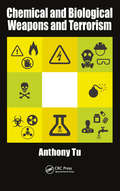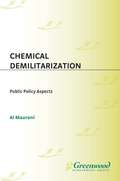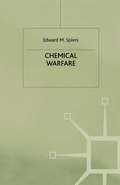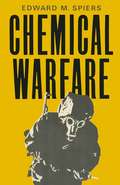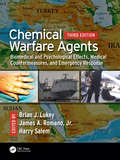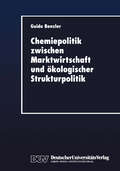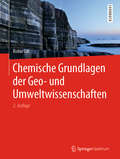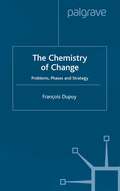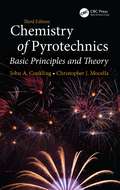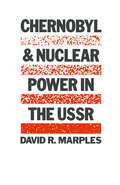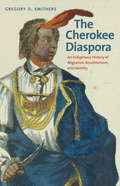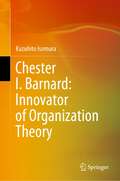- Table View
- List View
Chemical and Biological Weapons and Terrorism
by Anthony TuWritten by the world’s leading expert on the Tokyo sarin attacks, Chemical and Biological Weapons and Terrorism is a comprehensive examination of the use, detection, and prevention of chemical and biological attacks. Divided in two parts, one devoted to chemical and the other biological weapons, this book emphasizes defense, decontamination, detection, treatment, mechanism of toxic action, and pathological effects in the case of each. Covering a diverse range of substances, chapters draw on detailed case studies on the US anthrax attacks, the Tokyo sarin gas attacks, as well as an entire chapter devoted to the Iran-Iraq War co-authored with Dr. Sayid Abbas Foroutan, a former Iranian military surgeon who actively participated in the treatment of Iranian soldiers suffering from gas poisoning. Features include: A case study of the Tokyo sarin gas attacks from the leading expert on the subject A detailed case study on the U.S. anthrax attacks A chapter on the Iran-Iraq War and controversial weapons co-authored with an Iranian military surgeon with first-hand knowledge of the subject Details on the various ways chemical and biological weapons can be constructed and deployed Applicable defense strategies, including detection of materials and decontamination in the event chemical/biological weapons are deployed Featuring over 100 unique photographs and detailed chemical structures, Chemical and Biological Weapons and Terrorism is essential reading for counterterrorism experts, first responders and medical professionals, security consultants and military personnel seeking to expand their knowledge of preventative strategies. The book also will serve as a great resource for students in homeland security, public administration, and criminal justice programs.
Chemical Control: Regulation of Incapacitating Chemical Agent Weapons, Riot Control Agents and their Means of Delivery (Global Issues)
by Michael CrowleyThis thoroughly researched study highlights the international community's failure to regulate contemporary state research, development, marketing and/or deployment of riot control agents and incapacitating chemical agent weapons.
Chemical Demilitarization: Public Policy Aspects (Non-ser.)
by Albert J. MauroniFor more than 15 years, the Army's chemical demilitarization program has been criticized and castigated as a potentially dangerous effort, poorly executed without concern for the public. By reviewing the chemical demilitarization program as a public policy area, Mauroni offers a different perspective on how the Army worked with Congress and the public to offer the safest program possible. The Army was forced to delay its own schedule and increase the breadth and depth of the program to address political demands and idealistic environmental concerns. Mauroni contends that Army and Department of Defense leadership's insistence on treating this program as a strictly technical effort, rather than as a public policy concern is in part responsible for the public's misunderstanding of the Army's execution of the program.Despite its challenges, the Army is well on its way to accomplishing its goal of destroying the U.S. chemical weapons stockpile with no impact on the public or environment. They have stumbled through, however, rather than planned their exit. According to Mauroni, the Army needs to examine this program carefully to identify how to address public policy questions better in the future, to include responding to chemical and biological terrorism, developing a biological warfare vaccine program, and addressing future Gulf War illness questions. Their failure to learn will otherwise result in a continued inability to address critical questions on how they respond to chemical and biological warfare issues.
Chemical Warfare: A Study in Restraints (PDF)
by Frederic Joseph BrownWhy would a nation, in the midst of a vicious and unrestricted war, hesitate to employ a weapon guaranteed to inflict massive casualties on the enemy? Major Frederic Brown offers here the first critical analysis of this curious World War II phenomenon. He investigates the nature of restraints-political, military, economic, and psychological-operative in varying degrees between 1919 and 1945, when U.S. chemical warfare policy was being formed. Starting with the experiences of toxic agent use during World War I, Major Brown shows how various restraints to gas warfare developed during the inter-war years. He then discusses the World War II experience. In the conclusion Major Brown relates his findings to contemporary conflicts and offers important implications for the future of the cold war.Originally published in 1968.The Princeton Legacy Library uses the latest print-on-demand technology to again make available previously out-of-print books from the distinguished backlist of Princeton University Press. These editions preserve the original texts of these important books while presenting them in durable paperback and hardcover editions. The goal of the Princeton Legacy Library is to vastly increase access to the rich scholarly heritage found in the thousands of books published by Princeton University Press since its founding in 1905.
Chemical Warfare
by Edward M. SpiersEver since its employment in the First World War, chemical warfare has always aroused controversy. Governments have responded by pursuing the policies of disarmament and deterrence in the hope of avoiding its recurrence. However, despite the signing of the Geneva Protocol in 1925 which banned the use of poison gas, chemical weapons have been used in subsequent conflicts and most recently in the Gulf War between Iraq and Iran. In this work the policies of disarmament and deterrence will be reassessed within a broad historical and strategic context. It will be argued that poison gas could still be used in a modern European conflict; that the Soviet forces are the best equipped to operate in a contaminated environment; and that weaknesses persist in NATO's anti-chemical defences and in her deterrent. It will be emphasised, too, that the Geneva disarmament talks, which have made some progress in recent years, still face formidable difficulties over the issues of verification and compliance. Above all, it will be claimed that the onset of nuclear parity between the superpowers has eroded the credibility of a deterrent to chemical attack based upon the threat of nuclear release. Accordingly, this book will contend that the United States should modernize her stockpile of chemical weapons to bolster the Western deterrent and to provide more leverage for the negotiations in Geneva.
Chemical Warfare
by Edward M. SpiersA reassessment of the policies of disarmament and deterrence within a broad historical and strategic context. The author argues that poison gas could still be used in a modern European conflict and that weaknesses persist in NATO's anti-chemical defences and its deterrent.
Chemical Warfare Agents: Chemistry, Pharmacology, Toxicology, and Therapeutics, Second Edition
by Brian J. Lukey James A. Romano Harry Salem James A. Romano Jr.The first edition of this book, Chemical Warfare Agents: Toxicity at Low Levels, was published just prior to the terrorist attacks of September 11th, 2001. Reflecting a greater sense of urgency within the field of chemical defense since this event, research related to chemical warfare agents (CWAs) continues to expand at a remarkable pace. <
Chemical Warfare Agents: Biomedical and Psychological Effects, Medical Countermeasures, and Emergency Response
by Brian J. Lukey James A. Romano Jr. Harry SalemThe first edition of this book, Chemical Warfare Agents: Toxicity at Low Levels, was published just prior to the terrorist attacks of September 11, 2001. The second edition titled, Chemical Warfare Agents: Pharmacology, Toxicology, and Therapeutics, included new epidemiological and clinical studies of exposed or potentially exposed populations; new treatment concepts and products; improved organization of the national response apparatus addressing the potential for CWA terrorism; and improved diagnostic tests that enable rapid diagnosis and treatment. Since the second edition, the chemical warfare agent community has worked hard to advance research for protection and treatment and develop/improve response approaches for individuals and definitive care. Consequently, in addition to updating previous chapters, Chemical Warfare Agents: Biomedical and Psychological Effects, Medical Countermeasures, and Emergency Response, Third Edition features several new chapters that address the Syrian War, chemical destruction, the Organisation for the Prohibition of Chemical Weapons, biomarkers for chemical warfare agent exposure, field sensors, aircraft decontamination, lung/human on a chip, chemical warfare response decision making, and other research advancements. Features: Describes the newest medical interventions, and the latest technologies deployed in the field, as well as developments in the international response to CW usage highlighting recent events in the Middle East Discusses the latest in organizational/interagency partitioning in terms of responsibilities for emergency response, not just in the United States but at the international level—whether prevention, mitigation, medical care, reclamation, or medico-legal aspects of such response Contains the most current research from bench-level experts The third edition contains the most up-to-date and comprehensive coverage of the question of chemical warfare agent employment on the battlefield or in terrorism. Edited by workers that have been in the field for 35+ years, it remains faithful to the scientific "constants," while evaluating and crediting the advances by the industry that have made us safer.
Chemical Warfare Agents: Biomedical and Psychological Effects, Medical Countermeasures, and Emergency Response
by Brian J. Lukey James A. Romano Jr. Harry SalemThe first edition of this book, Chemical Warfare Agents: Toxicity at Low Levels, was published just prior to the terrorist attacks of September 11, 2001. The second edition titled, Chemical Warfare Agents: Pharmacology, Toxicology, and Therapeutics, included new epidemiological and clinical studies of exposed or potentially exposed populations; new treatment concepts and products; improved organization of the national response apparatus addressing the potential for CWA terrorism; and improved diagnostic tests that enable rapid diagnosis and treatment. Since the second edition, the chemical warfare agent community has worked hard to advance research for protection and treatment and develop/improve response approaches for individuals and definitive care. Consequently, in addition to updating previous chapters, Chemical Warfare Agents: Biomedical and Psychological Effects, Medical Countermeasures, and Emergency Response, Third Edition features several new chapters that address the Syrian War, chemical destruction, the Organisation for the Prohibition of Chemical Weapons, biomarkers for chemical warfare agent exposure, field sensors, aircraft decontamination, lung/human on a chip, chemical warfare response decision making, and other research advancements. Features: Describes the newest medical interventions, and the latest technologies deployed in the field, as well as developments in the international response to CW usage highlighting recent events in the Middle East Discusses the latest in organizational/interagency partitioning in terms of responsibilities for emergency response, not just in the United States but at the international level—whether prevention, mitigation, medical care, reclamation, or medico-legal aspects of such response Contains the most current research from bench-level experts The third edition contains the most up-to-date and comprehensive coverage of the question of chemical warfare agent employment on the battlefield or in terrorism. Edited by workers that have been in the field for 35+ years, it remains faithful to the scientific "constants," while evaluating and crediting the advances by the industry that have made us safer.
Chemical Warfare, Chemical Disarmament: Beyond Gethsemane
by Valerie AdamsA study of the issues raised by chemical warfare, which examines the use of chemical weapons in wartime and analyzes allegations that certain countries, including the Soviet Union, are waging chemical warfare. The author examines the negotations currently underway regarding chemical deployment.
Chemical Warrior: Syria, Salisbury and Saving Lives at War
by Hamish de Bretton-GordonGRIPPING, MOVING AND INSPIRING: the remarkable life of a world-leading expert in chemical weapons defence. "His work has saved lives and given hope." - Professor David Nott, bestselling author of War DoctorFor thirty years, Hamish has served and volunteered in conflict zones around the world. As the army's foremost chemical weapons expert, he built a unique first-hand understanding of how to prevent attacks and train doctors on the frontline - saving countless lives in the process. After suffering near-death experiences time and again, Hamish discovered he had a ticking time bomb in his own chest: a heart condition called Sudden Death Syndrome that could kill him at any time. But with a new awareness for the fragility of life, he fought harder to make his count.Despite facing extraordinary personal danger, Hamish has unearthed evidence of multiple chemical attacks in Syria and continues to advise the government at the highest level, including after the 2018 Novichok poisoning in Salisbury. Lifting the lid on Hamish's unique world of battlefield expertise and humanitarian work, Chemical Warrior is a thrilling story of bravery and compassion.
Chemical Weaponry: A Continuing Challenge
by Edward M. SpiersChemical weapons are still a viable military option. This book assesses their appeal by examining how the agents, munitions and protective equipment of chemical warfare have evolved since 1915; how technological innovations and refinements in weaponry have altered tactical assumptions; and how these weapons have been employed in conflicts from the First World War to the Gulf War. The author argues that the weapon technology has proved inherently dynamic, that a new generation of biochemical agents may soon be available, and that arms control may not be able to curb these developments.
Chemiepolitik zwischen Marktwirtschaft und ökologischer Strukturpolitik: Ein ökonomischer Beitrag zum Umgang mit Produktrisiken in der Chemischen Industrie (DUV Wirtschaftswissenschaft)
by Guido BenzlerIm Gegensatz zur meist naturwissenschaftlich und ökonomisch-interventionistisch geführten chemiepolitischen Diskussion setzt sich der Autor mit der Notwendigkeit einer expliziten Lenkung der Entwicklung der Chemischen Industrie auseinander.
Chemische Grundlagen der Geo- und Umweltwissenschaften
by Robin GillChemische Grundlagen sind die Basis für einen großen Teil der Geowissenschaften. Studierende der Geowissenschaften benötigen daher zunehmend ein solides Verständnis der chemischen Grundlagen, um ihr Studium erfolgreich zu absolvieren. Die erweiterte zweite Auflage dieses beliebten Lehrbuchs führt die Studenten in diese "georelevante" Chemie ein, die in demselben klaren und verständlichen Stil wie die Vorauflage präsentiert wird. Die neue Auflage wurde jedoch um den Bereich der Umweltgeowissenschaften erweitert und enthält ein neues Kapitel, in dem die Isotopengeochemie vorgestellt wird.Das Buch umfasst drei große, gegliederte Teile. Der erste (Kapitel 1-4) befasst sich mit der grundlegenden physikalischen Chemie geologischer Prozesse. Der zweite Teil (Kapitel 5-8) führt in die wellenmechanische Sicht auf das Atom ein und erklärt die verschiedenen Arten chemischer Bindungen, die den Materialien der Erde ihre vielfältigen und charakteristischen Eigenschaften verleihen. Die Schlusskapitel (9-11) geben einen Überblick über die geologisch relevanten Elemente und Isotope und erklären ihre Entstehung und ihre Häufigkeit im Kosmos und auf der Erde. Das Buch schließt mit einem umfangreichen Glossar von Begriffen; die Anhänge behandeln grundlegende Mathematik, erklären die grundlegende Lösungschemie und listen die chemischen Elemente und die im Buch verwendeten Symbole, Einheiten und Konstanten auf.Die Übersetzung wurde mit Hilfe von künstlicher Intelligenz (maschinelle Übersetzung durch den Service DeepL.com) angefertigt. Da die anschließende Überprüfung hauptsächlich im Hinblick auf inhaltliche Gesichtspunkte erfolgte, kann sich der Text des Buches stilistisch von einer konventionellen Übersetzung unterscheiden. Springer Nature arbeitet bei der Publikation von Büchern kontinuierlich mit innovativen Technologien, um die Arbeit der Autoren unterstützen.
The Chemistry of Change: Problems, Phases and Strategy
by F. DupuyFollowing on from his previous book, The Customer's Victory , François Dupuy here outlines how to manage a change process. Using practical examples from new case studies and discussion of current theories of organisational change this book explains how true organisational change can be effected in both private businesses and public organisations. With a strong pedagogical format, case studies and a helpful glossary of terms, this is an invaluable guide both for managers having to deal with change implementation and for students and researchers of change management.
Chemistry of Pyrotechnics: Basic Principles and Theory, Third Edition
by Chris Mocella John A. ConklingThis book provides chemists with technical insight on pyrotechnics and explosives. It emphasizes basic chemical principles and practical, hands-on knowledge in the preparation of energetic materials. It examines the interactions between and adaptations of pyrotechnics to changing technology in areas such as obscuration science and low-signature flame emission. The updated third edition discusses chemical and pyrotechnic principles, components of high-energy materials, elements of ignition, propagation, and sensitivity. It offers heat compositions, including ignition mixes, delays, thermites, and propellants and investigates the production of smoke and sound as well as light and color.
Chemistry of Pyrotechnics: Basic Principles and Theory, Third Edition
by Chris Mocella John A. ConklingThis book provides chemists with technical insight on pyrotechnics and explosives. It emphasizes basic chemical principles and practical, hands-on knowledge in the preparation of energetic materials. It examines the interactions between and adaptations of pyrotechnics to changing technology in areas such as obscuration science and low-signature flame emission. The updated third edition discusses chemical and pyrotechnic principles, components of high-energy materials, elements of ignition, propagation, and sensitivity. It offers heat compositions, including ignition mixes, delays, thermites, and propellants and investigates the production of smoke and sound as well as light and color.
Chernobyl: A Documentary Story
by Iurii Shcherbak trans Ian PressA documentary account of the Chernobyl disaster of April 1986, this is based on interviews with many of the participants. Shcherbak considers Chernobyl to be the most important event in the USSR since World War II and felt compelled to go and live there and interview those involved.
The Chernobyl Effect: Antinuclear Protests and the Molding of Polish Democracy, 1986–1990 (Protest, Culture & Society #32)
by Kacper Szulecki Tomasz Borewicz Janusz WaluszkoThe 1986 Chernobyl catastrophe was not only a human and ecological disaster, but also a political-ideological one, severely discrediting Soviet governance and galvanizing dissidents in the Eastern Bloc. In the case of Poland, what began as isolated protests against the Soviet nuclear site grew to encompass domestic nuclear projects in general, and in the process spread across the country and attracted new segments of society. This innovative study, combining scholarly analysis with oral histories and other accounts from participants, traces the growth and development of the Polish anti-nuclear movement, showing how it exemplified the broader generational and cultural changes in the nation’s opposition movements during the waning days of the state socialist era.
The Chernobyl Effect: Antinuclear Protests and the Molding of Polish Democracy, 1986–1990 (Protest, Culture & Society #32)
by Kacper Szulecki Tomasz Borewicz Janusz WaluszkoThe 1986 Chernobyl catastrophe was not only a human and ecological disaster, but also a political-ideological one, severely discrediting Soviet governance and galvanizing dissidents in the Eastern Bloc. In the case of Poland, what began as isolated protests against the Soviet nuclear site grew to encompass domestic nuclear projects in general, and in the process spread across the country and attracted new segments of society. This innovative study, combining scholarly analysis with oral histories and other accounts from participants, traces the growth and development of the Polish anti-nuclear movement, showing how it exemplified the broader generational and cultural changes in the nation’s opposition movements during the waning days of the state socialist era.
The Cherokee Diaspora: An Indigenous History of Migration, Resettlement, and Identity (The Lamar Series in Western History)
by Gregory D. SmithersThe Cherokee are one of the largest Native American tribes in the United States, with more than three hundred thousand people across the country claiming tribal membership and nearly one million people internationally professing to have at least one Cherokee Indian ancestor. In this revealing history of Cherokee migration and resettlement, Gregory Smithers uncovers the origins of the Cherokee diaspora and explores how communities and individuals have negotiated their Cherokee identities, even when geographically removed from the Cherokee Nation headquartered in Tahlequah, Oklahoma. Beginning in the eighteenth century, the author transports the reader back in time to tell the poignant story of the Cherokee people migrating throughout North America, including their forced exile along the infamous Trail of Tears (1838–39). Smithers tells a remarkable story of courage, cultural innovation, and resilience, exploring the importance of migration and removal, land and tradition, culture and language in defining what it has meant to be Cherokee for a widely scattered people.
The Chessboard and the Web: Strategies of Connection in a Networked World (The Henry L. Stimson Lectures Series)
by Anne-Marie SlaughterFrom a renowned foreign-policy expert, a new paradigm for strategy in the twenty-first century In 1961, Thomas Schelling’s The Strategy of Conflict used game theory to radically reenvision the U.S.-Soviet relationship and establish the basis of international relations for the rest of the Cold War. Now, Anne-Marie Slaughter—one of Foreign Policy’s Top 100 Global Thinkers from 2009 to 2012, and the first woman to serve as director of the State Department Office of Policy Planning—applies network theory to develop a new set of strategies for the post-Cold War world. While chessboard-style competitive relationships still exist—U.S.-Iranian relations, for example—many other situations demand that we look not at individual entities but at their links to one another. We must learn to understand, shape, and build on those connections. Concise and accessible, based on real-world situations, on a lucid understanding of network science, and on a clear taxonomy of strategies, this will be a go-to resource for anyone looking for a new way to think about strategy in politics or business.
Chester I. Barnard: Innovator of Organization Theory
by Kazuhito IsomuraThis book looks at Chester I. Barnard’s theoretical and practical contributions to organization theory by examining his life, career, experience, intellectual relationships, philosophy, method, and theory.Barnard (1886–1961) is considered an innovator in the field with the publication of his seminal work, The Functions of the Executive, in 1938. But why was Barnard able to publish such a groundbreaking book despite the fact that he was a practitioner, not an academic researcher? In pursuit of that question, this book carefully investigates the background of his ideas about management, such as his experience, philosophy, and method. It then traces the process of how Barnard built his concepts of organization as it examines his books, published papers, unpublished manuscripts, and correspondence and systematically summarizes how he built his theory of organization and management. Finally, the author explores how Barnard’s theory has the potential to be developed and put into practice by examining his important works after his publication of The Functions of the Executive, which is well known as abstract and difficult. Readers of this present book will come away with a clearer and more systematic understanding of Barnard’s theoretical and practical contributions to the field.
The Chestnut Man: The gripping debut novel from the writer of The Killing
by Søren SveistrupTHE GRIPPING DEBUT NOVEL FROM THE CREATOR AND WRITER OF HIT TV SHOW THE KILLING_____________ October, Copenhagen. The police make a terrible discovery - a young woman is found brutally murdered, with one of her hands cut off.Next to her lifeless body hangs a strange doll made of chestnuts . . . Assigned to the case is young and ambitious detective Naia Thulin, and Mark Hess, a burnt-out investigator who has just been kicked out of Europol. Struggling for leads they come across a mysterious piece of forensic evidence that doesn't quite fit. It points to a missing girl, presumed dead - the daughter of politician Rosa Hartung. But a man has already confessed to her murder, and the case is long since closed. The body count keeps rising, as another woman is found murdered. Once again, a chestnut man is found with the victim. Thulin and Hess need to make the connection between all three crimes, and fast, because it's clear the murderer is on a mission that's far from over . . . Fans of The Killing, The Girl with the Dragon Tattoo and Jo Nesbø will love this debut thriller. _____________Featured in BBC Top Fiction Picks of 2019, Guardian Books of 2019 & Inside Soap's Hot List'Creepy, clever and packed with tension' Sun'A full-throttle thriller in the tradition of classic Stieg Larsson, drenched in atmosphere and charged with adrenaline. Buckle up. You'll gulp down every word. I loved this book' A. J. Finn, author of The Woman In The Window_____________Praise for The Killing:'TV of the absolute finest quality . . . the writing shines' Guardian 'Excellent . . . A shrewd mix of police procedural, political thriller and domestic drama' New York Times'The most talked-about, boxset-friendly cultural landmarks of the 21st century to date' Independent
